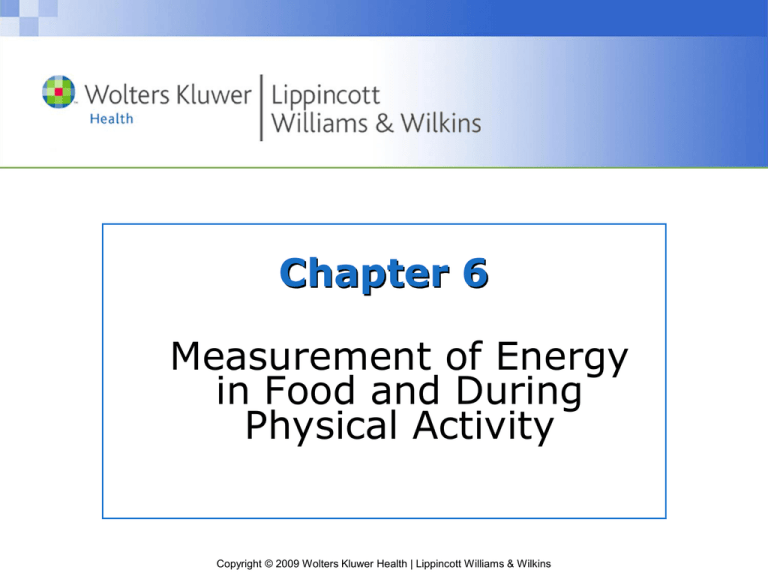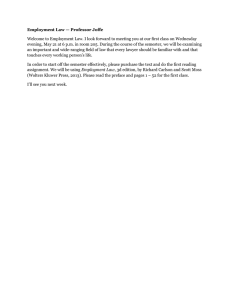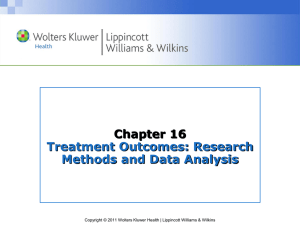Chapter 6 Measurement of Energy in Food and During Physical Activity
advertisement

Chapter 6 Measurement of Energy in Food and During Physical Activity Copyright © 2009 Wolters Kluwer Health | Lippincott Williams & Wilkins The Calorie Calorie • One calorie expresses the quantity of heat necessary to raise the temperature of 1 kg (1 L) of water by 1° Celsius. Kilocalorie (kCal) Kilojoule Megajoule Copyright © 2009 Wolters Kluwer Health | Lippincott Williams & Wilkins Conversions 1 cal = 4.186 J 1 kCal = 1000 cal = 4186 J 1 BTU = 778 ft. lb. = 252 cal = 1055 J Copyright © 2009 Wolters Kluwer Health | Lippincott Williams & Wilkins Temperature Versus Heat Temperature reflects a quantitative measure of an object’s hotness or coldness. Heat describes energy transfer from one body or system to another. Copyright © 2009 Wolters Kluwer Health | Lippincott Williams & Wilkins Bomb Calorimeter Measures total energy value of foods Type of direct calorimetry Sealed chamber charged with oxygen Increase in water temperature directly reflects the heat released during a food’s oxidation. Heat of combustion Copyright © 2009 Wolters Kluwer Health | Lippincott Williams & Wilkins Copyright © 2009 Wolters Kluwer Health | Lippincott Williams & Wilkins Heat of Combustion Carbohydrates • 4.2 kCal Lipids • 9.4 kCal Proteins • 5.65 kCal Copyright © 2009 Wolters Kluwer Health | Lippincott Williams & Wilkins Net Energy Value Actual energy available to the body Coefficient of digestibility • Affected by dietary fiber • Atwater general factors Carbohydrates: 4 Lipids: 9 Proteins: 4 Copyright © 2009 Wolters Kluwer Health | Lippincott Williams & Wilkins Direct Calorimetry Directly measures energy expenditure Human calorimeter • Airtight chamber • A person lives or works in the chamber for an extended period of time. Changes in water temperature relate directly to an individual’s energy metabolism. Copyright © 2009 Wolters Kluwer Health | Lippincott Williams & Wilkins Copyright © 2009 Wolters Kluwer Health | Lippincott Williams & Wilkins Indirect Calorimetry Indirect calorimetry infers energy expenditure from measurements of oxygen uptake and carbon dioxide production using: • Closed-circuit spirometry • Open-circuit spirometry Portable spirometry Bag technique Computerized instrumentation Doubly labeled water technique Copyright © 2009 Wolters Kluwer Health | Lippincott Williams & Wilkins Closed- and Open-Circuit Spirometry Closed-circuit • Subject breathes 100% oxygen from a prefilled container. • A canister of soda lime absorbs the carbon dioxide in exhaled air. Open-circuit • Subject inhales ambient air with 20.93% oxygen, 0.03% carbon dioxide, and 79.04% nitrogen. • Indirectly reflects the ongoing process of energy metabolism Copyright © 2009 Wolters Kluwer Health | Lippincott Williams & Wilkins Copyright © 2009 Wolters Kluwer Health | Lippincott Williams & Wilkins Portable Spirometry and Bag Technique Portable spirometry • Ambient air passes through a two-way valve. • Expired air travels through a gas meter that measures total expired air. Bag technique • Ambient air is breathed through one side of a valve. • Air is expelled through the other side of the valve. Copyright © 2009 Wolters Kluwer Health | Lippincott Williams & Wilkins Copyright © 2009 Wolters Kluwer Health | Lippincott Williams & Wilkins Copyright © 2009 Wolters Kluwer Health | Lippincott Williams & Wilkins Computerized Instrumentation Computerized instrumentation • A computer interfaces with at least three instruments: A system that continuously samples the subject’s expired air A flow-measuring device that records air volume breathed Oxygen and carbon dioxide analyzers that measure the composition of the expired gas mixture Copyright © 2009 Wolters Kluwer Health | Lippincott Williams & Wilkins Copyright © 2009 Wolters Kluwer Health | Lippincott Williams & Wilkins Doubly Labeled Water Technique Provides a useful way to estimate total daily energy expenditure in free-living conditions Expensive Provides an ideal way to assess total energy expenditure of groups over prolonged time periods Copyright © 2009 Wolters Kluwer Health | Lippincott Williams & Wilkins The Respiratory Quotient (RQ) The ratio of carbon dioxide produced to oxygen consumed The RQ provides information about the nutrient mixture catabolized for energy. The RQ equals 1.00 for carbohydrate, 0.70 for fat, and 0.82 for protein. Copyright © 2009 Wolters Kluwer Health | Lippincott Williams & Wilkins The Respiratory Exchange Ratio Ratio of carbon dioxide produced to oxygen consumed Computes in exactly the same manner as RQ R above 1.00 • Overbreathing • Exhaustive exercise R below 0.70 • Following exhaustive exercise Copyright © 2009 Wolters Kluwer Health | Lippincott Williams & Wilkins Energy Expenditure During Rest and Physical Activity Three factors determine total daily energy expenditure: • Resting metabolic rate • Thermogenic influence of food consumed • Energy expended during physical activity and recovery Copyright © 2009 Wolters Kluwer Health | Lippincott Williams & Wilkins Basal Metabolic Rate Minimum energy requirement sustains the body’s functions. Regular exercise slows a decrease in metabolism with age. Lower in females compared to males Copyright © 2009 Wolters Kluwer Health | Lippincott Williams & Wilkins Total Daily Energy Expenditure (TDEE) Influenced by: • Physical activity Accounts for between 15% and 30% TDEE • Dietary-induced thermogenesis Ranges between 10% and 35% of the ingested food energy • Climate • Pregnancy Copyright © 2009 Wolters Kluwer Health | Lippincott Williams & Wilkins The Metabolic Equivalent (MET) One MET represents an adult’s average seated, resting oxygen consumption or energy expenditure. MET provides a convenient way to rate exercise intensity with respect to a resting baseline. Copyright © 2009 Wolters Kluwer Health | Lippincott Williams & Wilkins






